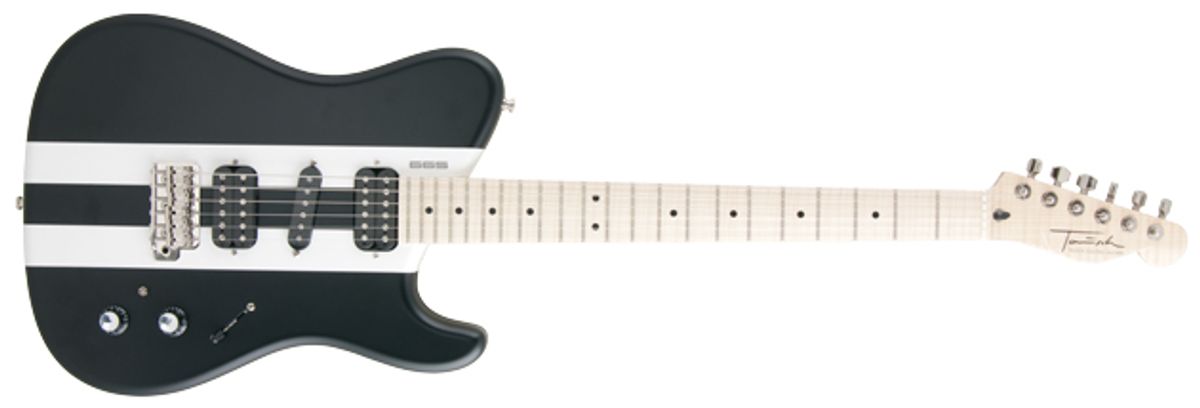
This immaculately built guitar’s semi-hollow body, long-scale fretboard, and coil-tap wiring deliver a carnival of tones.
Germany has seen its fair share of great guitar makers, from classical luthiers like Hermann Hauser to Roger Rossmeisl, best known for his unusual designs for Rickenbacker and Fender. Judging by the quality of the 665 model reviewed here you’d suspect Rainer Tausch is making a play to join their ranks.
Tausch takes his craft seriously. He makes no more than two electric guitars per month in his workshop, in Illertissen, Germany. And his work as an apprentice violinmaker and professional carpenter—as well as nearly two decades of lutherie—clearly informs his eye for detail. Tausch is also a player, and he fine-tunes his designs based on his own technical requirements, as well as feedback from his growing client base. Not surprisingly, the Tausch 665 feels like a true player’s guitar.
Uncommon Details and Top-Notch Construction At a glance, the 665 looks like a pretty conventional twist on the T-style platform. But the guitar is built around some interesting and idiosyncratic features that translate to a very individual sounding and multi-faceted instrument. Though it appears to be a solidbody, it’s actually a semi-hollow guitar built with a solid center block extending the length of the body. The body’s opaque finish obscures an uncommon tonewood, pear, which is similar in tonality to maple but less bright. In these two respects the Tausch echoes the all-maple bodied, semi-hollow designs by Roger Rossmeisel for Rickenbacker.
Set-neck construction distinguishes the Tausch from the many bolt-on T-style guitars out there. But the 26 3/16" scale is a much more profound and important deviation from T-style convention in terms of feel, playability, and tone. On the back of the guitar, the exposed tremolo cavity reveals a tremolo block crafted from pao ferro, which adds a hint of tonal warmth and reduces the guitar’s weight by 7 ounces.
Like a lot of retro-leaning electrics over the last few decades, the 665 pays homage to Fender’s ’69 competition-stripe Mustang finishes and Le Mans race cars of the period with a set of white racing stripes on the front and back. The paint scheme is complemented by a selection of black plastic components including the pickup covers, toggle-switch cover, and Gibson-style top hat knobs. The silver caps on the knobs nicely accent the nickel bridge and locking Sperzel tuners. Meanwhile, the flamed maple neck (a $500 option) adds a bit of natural elegance to the proceedings. The racing-stripe styling may not sit well with more traditionally minded players and feels a little cheap on such an expensive guitar, but it’s still thoughtfully executed and suits the guitars essentially mid-century informed lines.
Craftsmanship on the 665 is impeccable, which frankly, is what you’d expect from an instrument in this very exclusive price range. The bone nut is precisely notched and the 22 jumbo frets are perfectly crowned and dressed. The nitrocellulose finish has a faultlessly uniform matte texture that is extremely comfortable under the forearm.
Smorgasbord of Tones Weighing a mere six pounds, nine ounces, the 665 feels light and well balanced. Setup and intonation were perfect—smooth, low action and not a single dead spot anywhere. As a player accustomed to 24 3/4"-scale fretboards, I initially found the 665’s long scale to be disorienting and a bit cumbersome. But though I initially feared that more complex chords that are accessible on shorter necks might not be possible on this guitar, the super smooth action made more acrobatic chords easy.
A standard 665 comes with a Kluson tremolo unit, but the review model sported a Callaham system (a $250 option). With its Raw Vintage saddles and pop-in arm, the Callaham bridge is both old-school and modern, and it provides exceptionally smooth performance and tuning stability when the bar is manipulated.
Harry Häussel’s pickups may be less well known to stateside players, but they sound fantastic, and fit the Tausch like a glove. The neck and bridge humbuckers are alnico 2 and alnico 5 units respectively.
Ratings
Pros:
Impeccably built. A killer player that covers a lot of sonic territory.
Cons:
Very expensive. Race car-inspired cosmetics arguably cheapen an extraordinary guitar.
Tones:
Playability/Ease of Use:
Build/Design:
Value:
Street:
$5,250
Tausch Electric Guitars 665
tausch-guitars.com
Through a simple amp like a Fender Blues Junior, the guitar delivers straight-ahead rock rhythm work from the tight and slightly aggressive-sounding bridge pickup; warm, rounded woman tone and dark jazz tones from the neck pickup; and snappy, concise funk tones from the middle pickup. With the coil-tapping options, however, it isn’t too difficult to coax the glassy sound of a Stratocaster or the bright twang of a Tele from the bridge pickup.
Thanks to the extra string tension provided by the long scale, the guitar sounds and feels great in slackened tunings like dropped D. The guitar’s beautiful resonance and articulate voice also means that chords sound massive and detailed with distortion. No matter what the musical setting, though, the 665 maintains a warm, slightly woody, and sophisticated voice that’s no doubt the sum of the semi-hollow construction, set neck, long scale, and the Häussels.
The Verdict Tausch’s 665 is a superlative guitar in all respects. It’s incredibly well built, supremely playable, and possesses a refined voice that can be almost endlessly reshaped by the rangy Haussel pickups and coil-tapping system. With its hefty price tag, the instrument will have a fairly narrow audience. The long scale length may narrow that field further still, despite its many sonic advantages. But players with the means to afford the 665, not to mention a penchant for the unconventional, ought to seriously consider this fine specimen as a vehicle to expand and refine their own playing voice.
